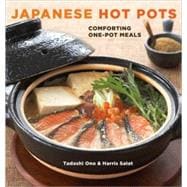
What is included with this book?
| Acknowledgments | p. vii |
| Introduction | p. 1 |
| The Basics | p. 5 |
| Basic Recipes | p. 29 |
| Dashi | p. 30 |
| Japanese Chicken Stock | p. 32 |
| Napa Cabbage-Spinach Rolls | p. 33 |
| Ponzu | p. 34 |
| Momiji Oroshi | p. 35 |
| Japanese Rice for Shime | p. 36 |
| Vegetables and Tofu | p. 37 |
| Mushroom Hot Pot | p. 39 |
| "Needle" Hot Pot | p. 40 |
| Kyoto Vegetable Hot Pot | p. 42 |
| Tofu Hot Pot | p. 45 |
| Kabocha Pumpkin Hot Pot | p. 47 |
| Rustic Soba Noodle Hot Pot | p. 48 |
| Hand-Pulled Noodle Hot Pot | p. 51 |
| Fish and other Seafood | p. 53 |
| Salmon Hot Pot | p. 55 |
| Monkfish Hot Pot | p. 56 |
| Halibut Hot Pot | p. 59 |
| Sea Bass Shabu-Shabu | p. 62 |
| Whole Fish Hot Pot | p. 64 |
| Yellowtail and Daikon Hot Pot | p. 66 |
| Black Cod and Soy Milk Hot Pot | p. 67 |
| Kyoto Mackerel-Miso Hot Pot | p. 69 |
| Old Tokyo Tuna-Belly Hot Pot | p. 71 |
| Sardine Dumplings Hot Pot | p. 72 |
| Hiroshima Oyster Hot Pot | p. 75 |
| "Sleet" Hot Pot | p. 77 |
| "Snow" Hot Pot | p. 78 |
| "Strawberry" Hot Pot | p. 81 |
| Squid Hot Pot | p. 82 |
| Fukagawa Clam Hot Pot | p. 83 |
| Crab Hot Pot | p. 85 |
| Pirate Hot Pot | p. 86 |
| Bay Scallops and Sea Urchin Hot Pot | p. 87 |
| "Anything Goes" Hot Pot | p. 89 |
| Oden | p. 91 |
| Chicken and Duck | p. 93 |
| Hakata Chicken Hot Pot | p. 95 |
| Nagoya Chicken Sukiyaki | p. 96 |
| Old Tokyo Chicken Hot Pot | p. 98 |
| Akita Hunter Hot Pot | p. 101 |
| Chicken and Milk Hot Pot | p. 103 |
| Sumo Wrestler Hot Pot | p. 105 |
| Chicken Curry Hot Pot | p. 107 |
| Duck and Duck Dumpling Hot Pot | p. 108 |
| Duck Gyoza Hot Pot | p. 111 |
| Beef, Pork, Lamb, and Venison | p. 113 |
| Beef Sukiyaki | p. 114 |
| Beef Shabu-Shabu | p. 117 |
| Shabu-Suki | p. 120 |
| Yokohama Beef Hot Pot | p. 123 |
| Beef and Taro Root Hot Pot | p. 124 |
| Pork Shabu-Shabu | p. 126 |
| Pork Miso Hot Pot | p. 127 |
| Pork and Greens Hot Pot | p. 128 |
| Hakata Pork Intestines Hot Pot | p. 130 |
| Pork Kimchi Hot Pot | p. 131 |
| Sake Brewer Hot Pot | p. 133 |
| Lamb Shabu-Shabu | p. 134 |
| Venison Hot Pot | p. 136 |
| Resources | p. 139 |
| Index | p. 143 |
| Table of Contents provided by Ingram. All Rights Reserved. |
The New copy of this book will include any supplemental materials advertised. Please check the title of the book to determine if it should include any access cards, study guides, lab manuals, CDs, etc.
The Used, Rental and eBook copies of this book are not guaranteed to include any supplemental materials. Typically, only the book itself is included. This is true even if the title states it includes any access cards, study guides, lab manuals, CDs, etc.
Excerpted from Japanese Hot Pots by Tadashi Ono, Harris Salat
All rights reserved by the original copyright owners. Excerpts are provided for display purposes only and may not be reproduced, reprinted or distributed without the written permission of the publisher.